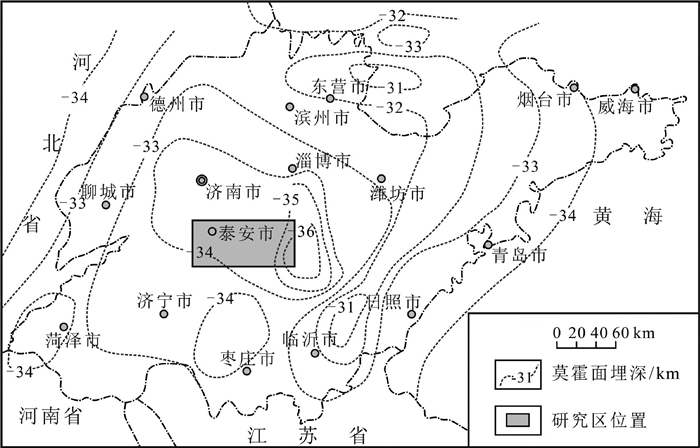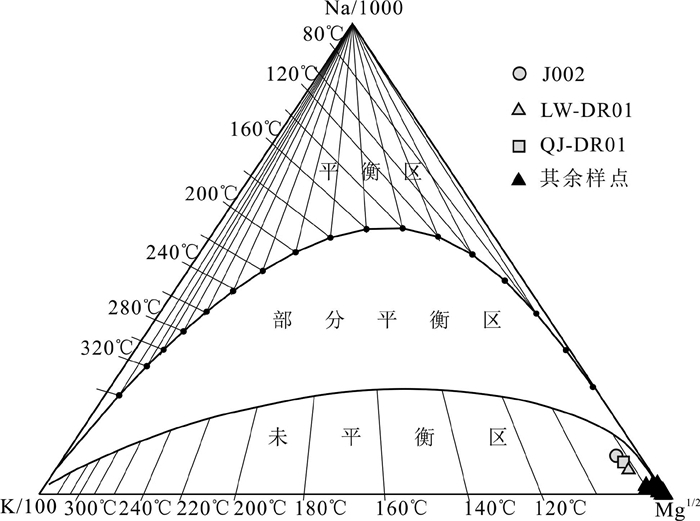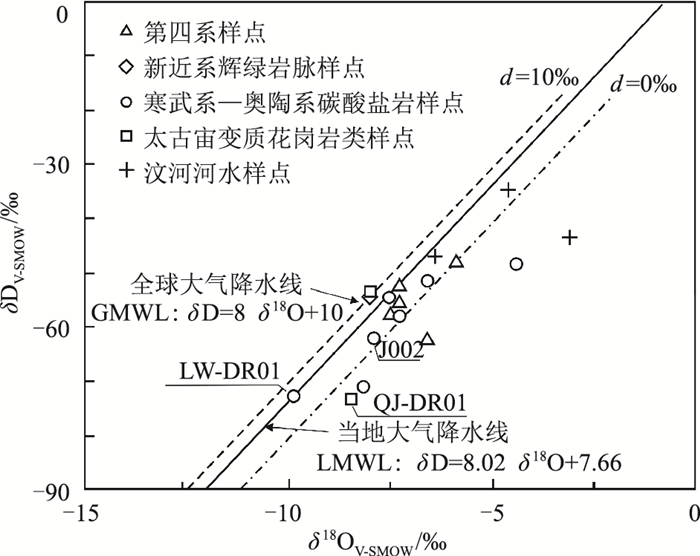Geothermal geological characteristics and genesis of hot water in the central mountain area of Shandong Province
-
摘要:
鲁中山区五级构造单元莱芜凹陷、东平凸起及新甫山凸起分布有热水资源。研究发现,不同构造位置热水埋深、热储类型及成因机制不尽相同。利用鲁中山区各构造单元典型地热井测温数据,热水与其他类型水体水化学组分、同位素对比分析结果,对地热地质特征、热水成因及热储温度值进行研究和计算。结果表明,大气降水为鲁中山区热水补给来源;区内热水水化学类型为SO4-Na·Ca型及SO4·R-Na·Ca型(R为Cl或HCO3);较其他水体,地热水同位素δ18O和δD表现为贫化特征;各热储温度值低于100℃,属于中低温热储范畴,且热水均为未成熟水,表明地热水水-岩相互作用尚未达到离子平衡状态,溶解作用仍在进行,或热水受到了外源冷水的混合作用。位于盆地内部的冷家庄地热系统属于热传导型,盆缘凸起的安驾庄及桥沟地热系统属于热对流型。研究结果对鲁中山区地热水资源开发提供了理论依据。
Abstract:There are hot water resources distributed in Laiwu Depression, Dongping Uplift and Xinfushan Uplift of the fifth grade structural unit in the central mountain area of Shandong Province.It is found that the burial depth of hot water, the type of thermal reservoir and the genetic mechanism are varied in different structural positions.Based on the temperature measurement data of typical geothermal wells, the hydrochemical composition and isotope comparative analysis of hot water with other types of water, the authors studied and calculated the geothermal geological characteristics, hot water genesis and thermal storage temperature value.The results show that the precipitation is the source of hot water supply.The chemical types of the hot water in this area are SO4-Na·Ca and SO4·R-Na·Ca(R standing for Cl or HCO3), with low δ 18O and δ D values compared with other waters.The calculated temperature value of each heat storage is lower than 100℃, suggesting a medium low temperature heat storage.The hot water is immature water, which indicates that the water rock interaction of geothermal water has not reached the ion equilibrium state, the dissolution is still in progress, or the hot water is mixed by exogenous cold water.The Lengjiazhuang geothermal system in the basin belongs to the heat conduction type, and the Anjiazhuang and Qiaogou geothermal systems in the basin margin uplifts belong to the thermal convection type.The research results provide a theoretical basis for the development of geothermal water resources in the central mountain area of Shandong Province.
-

-
图 2 山东莫霍面深度等值线(据参考文献[24]修改)
Figure 2.
表 1 鲁西隆起区大地热流数据
Table 1. The earth heat flow data sheet in the western Shandong uplift terrain
序号 位置 深度范围/m 地温梯度
/(℃·km-1)热导率/(W·(m·K)-1) 热流值/(mW·m-2) 数据来源 1 临沂市沂南县 100~300 24.5 2.81 62.4 [26] 2 莱芜市高庄镇 180~210 20.0 2.42 48.1 [26] 3 泰安市新汶镇 645~735 16.37±0.28 2.95±0.17 48.1 [26] 4 莱芜市凤城街道办 320~390 21.0 2.39 50.2 [26] 5 淄博市张店区 110~210 22.0 2.81 62.0 [26] 6 淄博市金岭镇 200~240 28.0 2.30 69.1 [26] 7 临沂市蒋峪镇 / 27.5 2.20 70.7 [27] 8 临沂市兰山区 / 19.8 3.46 66.1 [27] 表 2 鲁中山区典型地热井测温及地温梯度数据
Table 2. Temperature measurement and geothermal gradient data of typical geothermal wells in the mountainous area of central Shandong Province
地热井编号 井深/m 井底温度/℃ 地温梯度/(℃·100 m-1) 井底岩性 构造位置 LW-DR01 2700.7 82.3 2.86 奥陶系马家沟群碳酸盐岩 莱芜盆地内部 LW-T117 1195 41.2 2.15 石炭系—二叠系碎屑岩 莱芜盆地内部 LW-8-2 920 30.2 1.59 石炭系—二叠系碎屑岩 莱芜盆地内部 QG-DR01 468.0 48.4 7.4 太古宇变质岩 新甫山凸起与莱芜盆地毗连区 AJZ-ZK01 340.5 60.2 6.33 寒武系朱砂洞组白云岩 大汶口盆地与东平凸起接触带 表 3 鲁中山区典型地热井级周边水化学测试数据
Table 3. Hydrochemical test data of typical geothermal wells in the mountainous area of central Shandong Province
取样地点 原始编号 孔深
/m含水岩
组类型构造单元 测试项目/(mg·L-1) pH 水化学类型 δD δ18O Na+ K+ Ca2+ Mg2+ Cl- SO42- HCO3- F- SiO2 TDS V-SMOW/‰ 口镇小古城村 J059 501 O 莱芜盆地 18.0 4.0 101.6 48.9 19.9 194.9 310.6 3.3 16.6 559.0 7.6 HCO3·SO4-Ca·Mg -71.2 -8.2 口镇山头店村 J081 1200 O 68.0 3.8 39.7 17.9 18.2 9.1 351.6 0.6 6.6 340.0 7.7 HCO3-Na·Ca -48.4 -4.4 杨庄镇冷家庄(热) DR01 2700 O 481.1 25.3 371.4 58.4 246.1 1705.0 133.3 / 43.0 3078.0 7.2 SO4-Na·Ca -73.0 -9.9 寨里镇大鱼池村 J013 246 O 32.0 0.7 144.7 24.4 50.0 101.3 273.0 0.4 26.0 829.3 7.6 HCO3·SO4-Ca·Mg -58.1 -7.3 杨庄镇孟官庄 J251 163 N1β 48.0 1.3 36.1 17.4 11.0 17.3 273.0 0.3 16.3 281.0 7.9 HCO3-Na·Ca -54.3 -8.0 羊里镇郝家中荣 J124 17 Q 25.0 0.4 192.1 23.0 71.2 122.4 246.1 0.1 21.6 867.0 7.3 HCO3·SO4-Ca -57.7 -7.5 羊里镇何家官庄 J134 40 Q 15.0 0.6 73.9 28.6 13.3 4.5 398.5 0.2 23.2 562.3 7.7 HCO3-Ca·Mg -62.5 -6.6 寨里镇卞官庄瀛汶河 LW46 / 河水 10.0 1.6 110.6 23.1 56.3 99.7 167.0 0.3 4.9 488.0 7.9 HCO3·SO4-Ca·Mg -43.6 -3.1 北集坡镇旧县村 J2810 120 O 新甫山凸起-莱芜盆地毗连区 42.1 1.3 135.3 19.9 86.5 55.2 291.4 0.1 14.2 612.0 7.4 HCO3·Cl-Ca -54.7 -7.5 徂徕镇桥沟村(凉) J3603 165 ∈ 18.5 0.5 62.1 16.3 40.8 16.1 162.5 0.35 17.59 410.2 7.8 HCO3·Cl-Ca·Mg -54.4 -7.9 徂徕镇桥沟村(热) DR01 468 Ar 182.5 8.6 89.4 5.8 110.3 269.2 284.0 2.7 38.0 992.6 8.2 SO4·HCO3-Na·Ca -73.4 -8.5 房村镇西南望村 J3804 130 Ar 91.7 9.5 100.2 31.7 145.4 13.8 312.8 0.3 16.9 712.0 7.4 HCO3-Ca·Na -53.5 -8.0 徐家楼乡洪沟社区 J404 10 Q 46.0 1.7 134.7 31.5 115.2 16.1 282.2 0.2 14.2 685.0 7.4 HCO3-Ca·Mg -52.5 -7.3 省庄镇东苑庄村 J1217 10 Q 36.0 0.3 138.7 14.3 104.6 18.4 300.6 0.1 18.0 715.8 7.4 HCO3·Cl-Ca / / 北集坡镇旧县牟汶河 NL36 / 河水 68.2 10.0 56.1 17.5 147.1 25.3 141.1 0.6 < 0.5 415.0 7.8 Cl·SO4-Na·Ca -46.9 -6.4 安驾庄镇东赵村(热) J002 149 ∈ 大汶口盆地与东平凸起接触带 350.7 15.8 210.2 14.1 244.6 776.2 177.8 2.4 35.5 1810.0 7.9 SO4·Cl-Na·Ca -62.2 -7.9 安驾庄镇北赵村 AJZ10 130 ∈ 128.1 6.0 167.9 30.2 139.0 355.9 220.7 0.8 16.8 1020.0 8.0 SO4·Cl-Ca·Na -51.6 -6.6 堽城镇邵家庙村 AJZ31 15 Q 113.5 0.9 197.4 19.7 190.7 346.8 134.9 0.5 16.13 1113.8 8.0 SO4·Cl-Ca·Na -48.2 -5.9 马庄镇夏马庄村 J279 16 Q 109.3 3.7 341.1 78.4 279.4 489.4 220.7 0.4 17.0 1859.4 7.7 HCO3·Cl-Ca·Mg -55.6 -7.3 堽城镇前蔡家洼村 J038 13 Ar 24.6 2.9 102.4 10.3 46.1 102.3 159.4 0.5 27.6 542.2 8.1 HCO3·SO4-Ca -56.8 -7.4 蒋集镇苏家龙泉大汶河 AJZ03 / 河水 118.0 12.4 108.6 29.1 178.0 253.1 147.1 0.8 3.5 800.0 8.0 SO4·Cl-Ca·Na -34.7 -4.6 注:Q—第四系松散岩类;O—奥陶系碳酸盐岩类;∈—寒武系碳酸盐岩类;Ar—太古宇变质岩;N1β—新近纪辉绿岩 -
[1] Rybach L.Geothermal energy:sustainability and the environment[J].Geothermics, 2003, 32(4/6):463-470.
[2] Lund J W, Bjelm L, Bloomquist G, et al.Characteristics, development and utilization of geothermal resources[J].Episodes, 2008, 31(1):140-147. doi: 10.18814/epiiugs/2008/v31i1/019
[3] Lund J W, Toth A N.Direct utilization of geothermal energy 2020 worldwide review[C]//Proceedings World Geothermal Congress 2020, Reykjavik, Iceland, 2020: 1-39.
[4] Zhao X G, Wan G.Current situation and prospect of Chinas geothermal resources[J].Renewable and Sustainable Energy Reviews, 2014, 32(4):651-661.
[5] 王贵玲, 张薇, 梁继运, 等.中国地热资源潜力评价[J].地球学报, 2017, 38(4):449-459. https://www.cnki.com.cn/Article/CJFDTOTAL-DQXB201704002.htm
[6] 王贵玲, 刘彦广, 朱喜, 等.中国地热资源现状及发展趋势[J].地学前缘, 2020, 27(1):1-9. https://www.cnki.com.cn/Article/CJFDTOTAL-DXQY202001002.htm
[7] 周总瑛, 刘世良, 刘金侠.中国地热资源特点与发展对策[J].自然资源学报, 2015, 30(7):1210-1221. https://www.cnki.com.cn/Article/CJFDTOTAL-ZRZX201507013.htm
[8] Jaupart C, Labrosse S, Lucazeau F, et al.Temperatures, heat, and energy in the mantle of the Earth[J].Earth Systems and Environmental Sciences, 2015, 7:223-270.
[9] 毛小平.地热田高温异常成因机理及温度分布特征[J].地球学报, 2018, 39(2):216-224. https://www.cnki.com.cn/Article/CJFDTOTAL-DQXB201802009.htm
[10] 徐军祥, 康凤新.山东省地热资源[J].中国地质, 1999, (9):30-31. https://www.cnki.com.cn/Article/CJFDTOTAL-DIZI199909008.htm
[11] 栾光忠, 刘红军, 刘冬雁, 等.山东半岛温泉的地热属性及其特征[J].地球学报, 2002, 23(1):79-84. doi: 10.3321/j.issn:1006-3021.2002.01.014
[12] 杨询昌, 康凤新, 王学鹏, 等.砂岩孔隙热储地温场水化学场特征及地热水富集机理——鲁北馆陶组热储典型案例[J].地质学报, 2019, 93(3):738-750. https://www.cnki.com.cn/Article/CJFDTOTAL-DZXE201903016.htm
[13] 蔡有兄, 钟秀燕.山东省鲁中南地区典型地热田概述[J].山东国土资源, 2015, 31(5):24-30. https://www.cnki.com.cn/Article/CJFDTOTAL-SDDI201505010.htm
[14] 高宗军, 孙智杰, 杨永红, 等.山东省地热水水化学研究及赋存特征[J].科学技术与工程, 2019, 19(20):85-90. https://www.cnki.com.cn/Article/CJFDTOTAL-KXJS201920012.htm
[15] 吴立进, 赵季初, 李艾银, 等.鲁北坳陷区地热资源开发利用关键性问题研究[J].地质与勘探, 2016, 52(2):300-306. https://www.cnki.com.cn/Article/CJFDTOTAL-DZKT201602012.htm
[16] 刘志涛, 刘帅, 宋伟华, 等.鲁北地区砂岩热储地热尾水回灌地温场变化特征分析[J].地质学报, 2019, 93(s1):149-157. https://www.cnki.com.cn/Article/CJFDTOTAL-DZXE2019S1019.htm
[17] 冯守涛, 王成明, 杨亚宾, 等.砂岩热储回灌对储层影响评价——以鲁西北坳陷地热区为例[J].地质学报, 2019, 93(s1):158-167. https://www.cnki.com.cn/Article/CJFDTOTAL-DZXE2019S1020.htm
[18] 刘元晴, 周乐, 李伟, 等.鲁中山区下寒武统朱砂洞组似层状含水层成因分析[J].地质论评, 2019, 65(3):653-663. https://www.cnki.com.cn/Article/CJFDTOTAL-DZLP201903012.htm
[19] 李少俊, 李三忠, 李玺瑶, 等.鲁西地块新生代断裂体系活动性与深部动力机制[J].海洋地质与第四纪地质, 2018, 38(4):123-134. https://www.cnki.com.cn/Article/CJFDTOTAL-HYDZ201804010.htm
[20] 李守军, 郑德顺, 蔡进功, 等.鲁北和鲁西南地区古近纪盆地沉积特征与控制因素探讨[J].地质论评, 2003, 49(3):225-232. doi: 10.3321/j.issn:0371-5736.2003.03.001
[21] 刘元晴, 周乐, 李伟, 等.山东莱芜盆地西北缘古近系半固结含水岩组的特征及其成因[J].地球学报, 2018, 39(6):737-748. https://www.cnki.com.cn/Article/CJFDTOTAL-DQXB201806011.htm
[22] 康凤新, 徐军祥, 张中祥.山东省地下水资源及其潜力评价[J].山东国土资源, 2010, 26(8):4-12. doi: 10.3969/j.issn.1672-6979.2010.08.002
[23] 张增奇, 张成基, 王世进, 等.山东省地层侵入岩构造单元划分对比意见[J].山东国土资源, 2014, 30(3):1-23. doi: 10.3969/j.issn.1672-6979.2014.03.001
[24] 高宗军, 吴立进, 曹红.山东省地热资源及其开发利用[J].山东科技大学学报(自然科学版), 2009, 28(2):1-7. doi: 10.3969/j.issn.1672-3767.2009.02.001
[25] 龚育龄, 王良书, 刘绍文, 等.济阳坳陷大地热流分布特征[J].中国科学(D辑), 2003, 33(4):384-391. https://www.cnki.com.cn/Article/CJFDTOTAL-JDXK200304010.htm
[26] 汪集旸, 黄少鹏.中国大陆地区大地热流数据汇编(第二版)[J].地震地质, 1990, 12(4):351-366. https://www.cnki.com.cn/Article/CJFDTOTAL-DZDZ199004010.htm
[27] 胡圣标, 何丽娟, 汪集旸.中国大陆地区大地热流数据汇编(第三版)[J].地球物理学报, 2001, 44(5):611-624. doi: 10.3321/j.issn:0001-5733.2001.05.005
[28] 姜光政, 高堋, 饶松, 等.中国大陆地区大地热流数据汇编(第四版)[J].地球物理学报, 2016, 59(8):2892-2910. https://www.cnki.com.cn/Article/CJFDTOTAL-DQWX201608015.htm
[29] 汪洋, 汪集旸, 熊亮萍, 等.中国大陆主要地质构造单元岩石圈地热特征[J].地球学报, 2001, 22(1):17-22. doi: 10.3321/j.issn:1006-3021.2001.01.004
[30] 刘春华, 王威, 卫润政.山东省水热型地热资源及其开发利用前景[J].中国地质调查, 2018, 5(2):51-56. https://www.cnki.com.cn/Article/CJFDTOTAL-DZDC201802008.htm
[31] 刘明亮, 何曈, 吴启帆, 等.雄安新区地热水化学特征及其指示意义[J].地球科学, 2020, 45(6):2221-2231. https://www.cnki.com.cn/Article/CJFDTOTAL-DQKX202006032.htm
[32] 史猛, 张杰, 殷焘, 等.胶东半岛中低温对流型地热资源水化学特征分析[J].地质学报, 2019, 93(s1):138-148. https://www.cnki.com.cn/Article/CJFDTOTAL-DZXE2019S1018.htm
[33] Giggenbach W F.Geothermal solute equilibria.Derivation of Na-K-Mg-Ca geoondicators[J].Geochimica et Cosmochimica Acta, 1988, 52(12):2749-2765. doi: 10.1016/0016-7037(88)90143-3
[34] 袁利娟, 孔祥军, 高剑, 等.北京市延庆地热田成因模式[J].地质论评, 2020, 66(4):933-941. https://www.cnki.com.cn/Article/CJFDTOTAL-DZLP202004014.htm
[35] 李泓泉, 张树胜, 谢明忠, 等.冀西北蔚县盆地地热资源赋存特征及勘查开发方向[J].地质论评, 2020, 66(4):919-932. https://www.cnki.com.cn/Article/CJFDTOTAL-DZLP202004013.htm
[36] Fournier R O.Chemical geothermometers and mixing models for geothermal systems[J].Geothermics, 1977, 5:31-40.
[37] 袁利娟, 杨峰田.北京迭断陷内蓟县系热储层温度分布特征[J].吉林大学学报(地球科学版), 2017, 47(1):179-188. https://www.cnki.com.cn/Article/CJFDTOTAL-CCDZ201701017.htm
[38] Langelier W F, Ludwig H F.Graphical methods for indicating the mineral character of natural waters[J].Journal of the American water works association, 1942, 34(3):335-352.
[39] Vaselli O, Minissable A, Tassi F, et al.A geochemical traverse across the Eastern Carpathians(Romania):constraints on the origin and evolution of the mineral water and gas discharges[J].Chemical Geology, 2002, 182(2):637-654.
[40] 柯柏林, 林天懿, 李文, 等.北京西山谷积山背斜地热系统成因模式及远景区预测[J].地质通报, 2019, 38(8):1378-1385. http://dzhtb.cgs.cn/gbc/ch/reader/view_abstract.aspx?file_no=20190814&flag=1
[41] 王贵玲, 蔺文静.我国主要水热型地热系统形成机制与模式[J].地质学报, 2020, 94(7):1923-1937. https://www.cnki.com.cn/Article/CJFDTOTAL-DZXE202007002.htm
[42] Muffler L J P.Tectonic and hydrological control of the nature and distribution of geothermal resources[C]//Proceedings, second U.N.symposium on the development and use of geothermal resources, Washington D.C: Government Printing Office, 1976: 499-507.
① 山东省地矿工程勘察院.山东省泰莱盆地地热资源成热预测研究报告.2010.
② 山东省地质矿产局第一地质队.山东省肥城市安驾庄地热田详查地质报告.1995.
③ 山东省第一地质矿产勘查院.山东省泰安市岱岳区徂徕镇地热资源普查报告.2003.
-




 下载:
下载:








